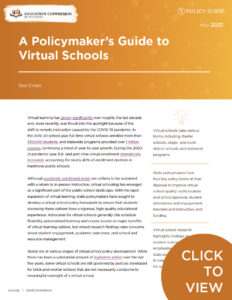Full- and part-time virtual schools take a variety of forms and operate within a unique policy context in each state. To help you make sense of it all, we created this Policy Guide outlining:
- Four types of virtual schools and how they are largely governed.
- Latest research on school and student performance.
- Four policy areas lawmakers can focus on, to ensure quality among virtual schools.
- Legislative examples and initiatives from at least 20 states.
We also track enacted and vetoed legislation concerning virtual schools in our State Education Policy Tracking tool. Select the “Online Learning” issue and the “Virtual Courses” sub-issue to see a list of legislation by state. There is additional legislation catalogued under the “Charter Schools” issue and “Cyber Charters” sub-issue.
It is important to note that this Policy Guide focuses only on virtual schools that offer full- or part-time instruction to students, which differs from remote learning that is necessitated by the COVID-19 pandemic school closures and in some cases, inclement weather. For more information on remote learning, see our Key Issue page.



